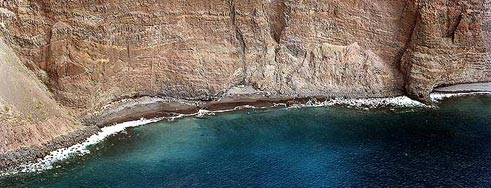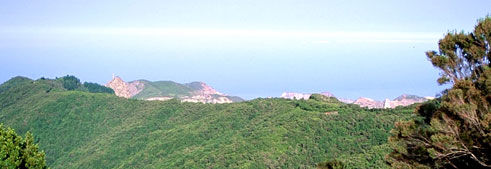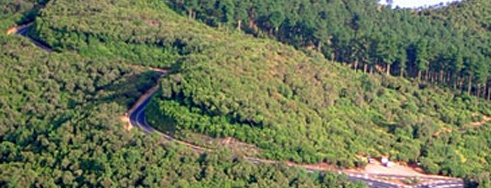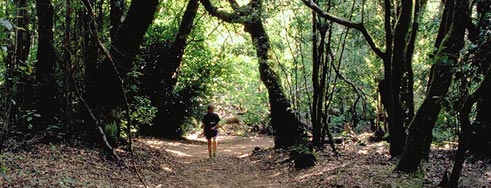- Keep on the marked paths.
- Do not disturb plants or animals.
- Follow the directions of the Park staff.
- Contribute to the Park maintenance, give suggestions and facilitate the achievement of its aims.
- Do not use appliances or strident noises at high volume. Listen to the sounds of nature and respect its silences. Everyone is entitled to enjoy the park.
- Do not throw waste. It is appropriate that each one return with his own garbage. In any case use the litter bins properly to facilitate the collection of garbage.
- Beware of fire. Do not smoke inside the forest fire or turn cookers except in recreational areas upgraded for this, when weather conditions permit.
- Neither camping nor bivouac are permitted.
- Bicycles are allowed on the roads paved and most of the sand tracks, except those for which is expressly indicated this prohibition. Bicycles are not allowed on the park trails.
- At recreational areas, it's forbidden to play football and other sports that could damage the natural grass.
Garajonay: Normas de visita y recomendaciones
-
Visit rules
-
Recommendations
Camping
For reasons of conservation, camping is not allowed inside the Park. At present, there is a single camping area, which is privately owned, located at the Hamlet of El Cedro.
-
When to come

The island, tanks to its warms and mild climate throughout the year offers food options for visits in every season.
If it is plant life that is your greatest interest, then the best period to come here is between March and June. During this period the flowering and development of the plants reaches it greatest splendour and colour. The rainiest period is from November to February but the rainy times rarely last for long and without a doubt you will be able to enjoy walking and swimming in the sea, as well as being able to see all of the green island, including the coast. From July to September is the driest and hottest period, and the island offers its driest face, but even at this time it is much less overpowering than in the Mediterranean for instance, with a pleasant coolness being maintained in the north of the island.
If what you are searching for is a direct encounter with the culture and the flavour of the autochthonous, at all times of year you can find folk singing and dancing, popular religious festivals and evenings although they are more prolific in summer. Tasting dishes and products of the local gastronomy (palm honey, guarapo, stews, leche asada, etc) can be enjoyed in the range of establishments which are available all over the island.
You can enjoy the beaches throughout the year. Some of them, such as those in Valle Gran Rey, are covered during part of the winter with pebbles and no sand, while in the springtime the sea will return the sand which it took away, offering some beautiful beaches of black sand.
-
How to get there

It is only possible to reach La Gomera by sea after a short crossing from the port of Los Cristianos in the south of Tenerife which crosses a channel of twenty-six kilometres. The ports of Los Cristianos (Tenerife) and San Sebastián (La Gomera) are connected by a number of companies with frequent services of some forty-five minutes' duration. From San Sebastián de la Gomera there are also boats which go to the other islands of El Hierro and La Palma.
Communications by air are limited to inter-island flights. The island's airport is located in the vicinity of Playa de Santiago.
-
Moving around

The island is not very large (373 Km2) and the network of roads is simple. The general road to the north (TF-711) and the central or dorsal road (TF-713) and the branches to the south and west constitute the main lines of communication.
The car is the most used manner of getting to know the island. Through a road layout that is rather sinuous, the connections are guaranteed. As secondary routes, there are numerous dirt tracks which lead to small hamlets. The Park is crossed by a number of roads, with the result that access is easy from any point on the island.
Mountain biking is a tough sport on this island due to the contours. The valleys, ravines, crests and mountainsides demand a good level of fitness if this system of transport is to be used. But if you love the bike, you will be able to enjoy routes with a certain degree of difficulty but of enormous beauty and variety.
The system of public transport, the buses, known as guaguas in the Canary Islands, link the capital with the main centres of Population in the Canary Islands. There are three lines which cover the routes in the north (as far as Vallehermoso), the south (as far as Santiago) and the west (as far as Valle Gran Rey). Many of the walks can be prepared with the use of the public buses, the timetable for which can be obtained from the Bus Station in San Sebastián or through the web page of the Island Authority, which runs the service.
-
Hiking

La Gomera is a paradise for hikers. A rich network of footpaths, almost all of wich are in superb condition, criss-crosses the island from north to south and from east to west.
Without any doubt, walking is the best way to discover the landscapes and corners: with the help of a footpath map of the island, you can find what you need in order to plan your excursions.
Visitor's guide
-
Park guide garajonay
-
Park brochure garajonay
-
How to get to the Park garajonay
-
Park map garajonay
-
Visitor centers garajonay
-
Itineraries garajonay
-
Recommendations garajonay
-
External services garajonay
Park information
-
Technical sheet
-
History
-
Natural environment
-
Cultural values
-
Socio-economical influence area
-
Conservation and biodiversity
-
Compatible uses


![Descargar guía de visita del Parque [C. Suárez Medina] Descargar guía de visita del Parque [C. Suárez Medina]](/en/parques-nacionales-oapn/red-parques-nacionales/parques-nacionales/garajonay/guia-visitante/recomendaciones/_jcr_content/root/container/container-main/container-side/highlights_list_serv/highlights_item27.coreimg.png/1689776099143/park-guide-tcm38-60635.png)
![Acceso a la Central de reservas [J.L.Perea] Acceso a la Central de reservas [J.L.Perea]](/en/parques-nacionales-oapn/red-parques-nacionales/parques-nacionales/garajonay/guia-visitante/recomendaciones/_jcr_content/root/container/container-main/container-side/highlights_list_serv/highlights_item49.coreimg.png/1689776099154/booking-office-tcm38-60005.png)
